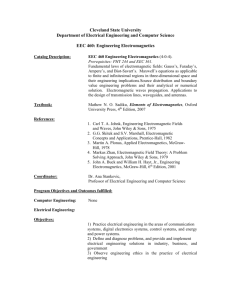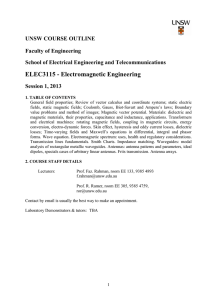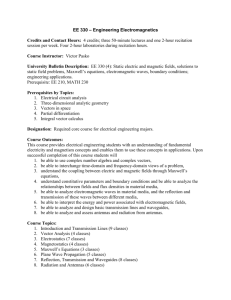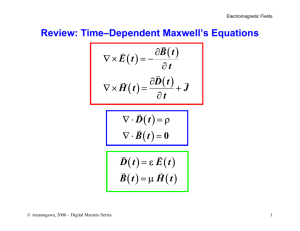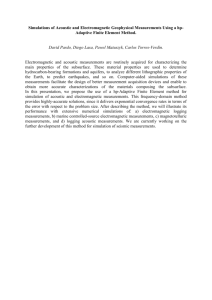ELEC3115 Electromagnetic Engineering Course Outline
advertisement
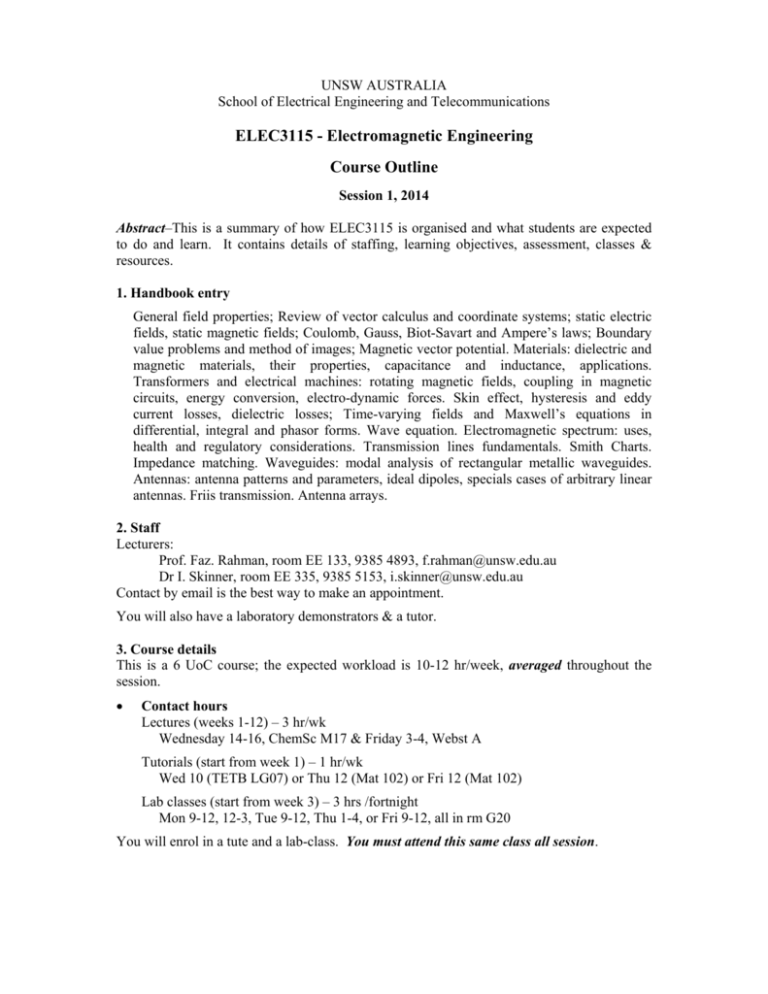
UNSW AUSTRALIA School of Electrical Engineering and Telecommunications ELEC3115 - Electromagnetic Engineering Course Outline Session 1, 2014 Abstract–This is a summary of how ELEC3115 is organised and what students are expected to do and learn. It contains details of staffing, learning objectives, assessment, classes & resources. 1. Handbook entry General field properties; Review of vector calculus and coordinate systems; static electric fields, static magnetic fields; Coulomb, Gauss, Biot-Savart and Ampere’s laws; Boundary value problems and method of images; Magnetic vector potential. Materials: dielectric and magnetic materials, their properties, capacitance and inductance, applications. Transformers and electrical machines: rotating magnetic fields, coupling in magnetic circuits, energy conversion, electro-dynamic forces. Skin effect, hysteresis and eddy current losses, dielectric losses; Time-varying fields and Maxwell’s equations in differential, integral and phasor forms. Wave equation. Electromagnetic spectrum: uses, health and regulatory considerations. Transmission lines fundamentals. Smith Charts. Impedance matching. Waveguides: modal analysis of rectangular metallic waveguides. Antennas: antenna patterns and parameters, ideal dipoles, specials cases of arbitrary linear antennas. Friis transmission. Antenna arrays. 2. Staff Lecturers: Prof. Faz. Rahman, room EE 133, 9385 4893, f.rahman@unsw.edu.au Dr I. Skinner, room EE 335, 9385 5153, i.skinner@unsw.edu.au Contact by email is the best way to make an appointment. You will also have a laboratory demonstrators & a tutor. 3. Course details This is a 6 UoC course; the expected workload is 10-12 hr/week, averaged throughout the session. Contact hours Lectures (weeks 1-12) – 3 hr/wk Wednesday 14-16, ChemSc M17 & Friday 3-4, Webst A Tutorials (start from week 1) – 1 hr/wk Wed 10 (TETB LG07) or Thu 12 (Mat 102) or Fri 12 (Mat 102) Lab classes (start from week 3) – 3 hrs /fortnight Mon 9-12, 12-3, Tue 9-12, Thu 1-4, or Fri 9-12, all in rm G20 You will enrol in a tute and a lab-class. You must attend this same class all session. ELEC3115 – Electromagnetic Engineering 2014 4. Syllabus & learning objectives Context and Summary Electromagnetics is of fundamental importance to electrical and computer engineers. Electromagnetic theory is indispensable in understanding electro-mechanical energy conversion, transmission & electric power utilization systems and communication systems, RF/microwave devices, optical fibre systems, antennas, remote sensing, radio astronomy, and electromagnetic compatibility. This course will consider electromagnetic theory as a general theory that includes the standard electro- and magneto-statics. The relationship between electric and magnetic fields, and their links expressed through the Maxwell equations, lead to wave propagation with associated wave behaviours. Finally, the course covers several aspects of electromagnetic applications such as capacitors, inductors, transformers, electromagnetic forces and power losses in electromagnetic systems (at low frequencies) and transmission lines, impendence matching circuits, waveguides, and antennas (at high frequencies). This course aims to give students the necessary background for the design and analysis of both low frequency electrical devices and high frequency electronic components. Assumed knowledge of this course includes undergraduate physics (PHYS1231), vector calculus (MATH2069), and basic circuit theory techniques. Aims The goal of ELEC3115 is to introduce basic electromagnetics and establish the fundamentals of devices in electromagnetic applications, as required by engineers in energy systems, telecommunications, computing and other technologies. Student will become familiar with electromagnetic applications such as capacitors, inductors, transformers, transmission lines, Smith charts, impendence matching circuits, waveguides and antennas, that are used in the designs and implementations of electrical power systems and modern wireless communications systems. Student Learning Outcomes For this course, we have identified the following specific Learning Outcomes: that students can use Gauss’, Ampere’s and Faraday’s Laws in the context of electrical devices design capacitors & inductors and analyse their characteristics solve simple boundary value problems, using the method of images and Poisson’s equation. calculate the forces that develop in electromagnetic actuators used in energy conversion and energy storage devices define core loss in an electromagnetic device, and recognise & describe its effect describe the engineering uses of electromagnetic waves, by frequency band, and the respective hazards associated with them distinguish between materials, based on their electromagnetic properties analyse problems involving TEM-waves recognise the limitations of standard LF & RF circuits apply the distributed circuit concepts needed at HF, specifically to match impedances and design HF components use and interpret a Smith chart describe & recognise fundamental properties of waveguide modes use dipole, antennas in simple communication links 2 ELEC3115 – Electromagnetic Engineering 2014 recognize and describe dispersion and its effects Additionally, students are expected to develop their communication skills by correctly using the appropriate terminology, and to demonstrate suitably professional skill and conduct in the context of an engineering laboratory. More precise details about the learning objectives can be found in a separate document available in moodle. 5. Relationship to other courses This is a third year course offered to students in a BE program at UNSW. It gives the foundation for electrical power systems and all conventional electronic communications (RF, mobile, microwave and optical). The course provides the background for those who will design and build elements of electrical power or communication systems. Prerequisites & assumed knowledge Students taking the course ELEC3115 will have successfully completed the Stage 1 courses PHYS1131/1231 Higher Physics 1A/1B. The mathematics needed for electromagnetism is covered in the course MATH2069 Mathematics 2A. Students who have not previously undertaken MATH2069 may find it necessary to put in extra work to learn this basic mathematical material. It is also assumed that students have good computer literacy and are able to use basic instruments such as an oscilloscope. Following courses This course provides essential basic understanding which is pre-requisite for ELEC3015 Electrical Energy Systems, a core course for specialization in Power Engineering. It also provides essential background to ELEC4604 RF Electronics, TELE4652 Mobile and Satellite Communications, and PHTN4661 Optical Circuits & Fibres. 6. Teaching & learning strategies This course consists of lectures, laboratory work, homework and tutorial work. Lectures The lectures will introduce a range of engineering electromagnetics. The lecture schedule is subject to change. Check moodle for the up-to-date version. Laboratory work The laboratory work provides students with opportunities to measure and characterize basic electromagnetic devices and applications. There are 5 labs to be completed during the session and students will do one every second week. Students choose a laboratory time when they enrol, and will do experiments in pairs. If you have a preferred partner in your lab-time, then let us know quickly! Students must comply with all H&S requirements and complete the relevant lab inductions before they may begin work. Each experiment has some required preparation, including a brief video introducing the equipment. All laboratory work must be recorded in a lab-book and not on loose sheets of paper. The lab work and the student’s performance will be assessed by the demonstrator, and a mark given at the end of lab session. More details about the laboratory activities can be found in a separate document available on moodle. 3 ELEC3115 – Electromagnetic Engineering 2014 Tutorial classes Tutorial classes provide students with an opportunity to discuss problems with others, while being guided by a staff member. Out of class work Lectures can only ever introduce the key ideas. Students must further reflect on these to fully develop their understanding. Students are encouraged to read the textbook and reference materials. Preparation for laboratory exercises provides further understanding of the experiment. The practice questions develop an in-depth quantitative understanding of basics of electromagnetic engineering. These problems take the student through all critical course topics and aim to develop and exercise their thinking skills. Students are expected to attempt complete all the problems, though not expected necessarily to successfully complete the harder ones (indicated as such in the question sheets). Making serious attempts to understand and complete these problems is the proven method to succeed in ELEC3115. On-line activities All course documents, laboratory support material, etc., will be available on moodle, as well as discussions, revision activities, and the Background Revision Quiz which focusses on the assumed background knowledge. 7. Assessment The final mark in the course will be calculated as follows: final exam class test laboratory related tutorial participation background quiz TOTAL 60 % 15 % 20 % 3% 2% 100 % Some bonus marks will also be available. Details about bonus marks will be available on moodle as the opportunities arise. Class-test A short class-test will be held in week 9. Exact date, time and location and format will be announced closer to these weeks. Laboratory work The laboratory component will run for 6 weeks. The lab work will be assessed by the demonstrator during the schedules lab classes and a consolidated mark provided at the end of session. Final exam The exam in this course will be a 3 hr written, closed book examination. University approved calculators are allowed. The examination tests analytical and critical thinking and general understanding of the course material in a controlled fashion. Assessment is a graded mark according the correct fraction of the answers to the exam questions. 4 ELEC3115 – Electromagnetic Engineering 2014 Revision Quiz This on-line quiz is available from O-week to the end of week 1. The purpose is to help you revise the assumed knowledge for this course. 8. Academic honesty and plagiarism Plagiarism is the unacknowledged use of others peoples work, including the copying of assignment works and laboratory results from other students. Plagiarism is considered a serious offence by the University and severe penalties may apply. For more information on plagiarism, please refer to: http://www.lc.unsw.edu.au/plagiarism. 9. Resources for students The course has a dedicated web-site on moodle. The following textbook is prescribed for the course: Field and Wave Electromagnetics - D. K. Cheng; 2nd edn, AddisonWesley; 1989 The following books are also good additional references: Electromagnetics -J. D. Kraus & D. A. Fleisch; McGraw Hill, fifth edition Applied Electromagnetics –S. Wentworth; J. Wiley, 2007 Lecturers may specify other references in class. Lectures about electrostatics & magnetostatics were recorded in 2010 and remain available at http://eemedia.ee.unsw.edu.au/ 10. Course evaluation and development Students are advised that this course is under constant revision in order to improve the learning outcomes of students. Please forward any feedback (positive or negative) directly to the course convener(s) or wait for the CATEI process. The following changes are being undertaken to improve the course based on the previous students’ feedback on the course: o A new method of assessing your lab work will be tried, in order to give you all better feedback. o Videos will be used to introduce the lab equipment to you. This was an explicit student suggestion. o A different of mode of working in the tutes will be tested. Student’s views at these innovations are welcome. 11. Administrative Matters For general expectations, rights, responsibilities such as attendance and workload of students, please refer to the School policies, at http://www.eet.unsw.edu.au/information-for/currentstudents/current-undergraduates . Student equity and diversity issues can be found via Student Equity Officers (Disability) in the Student Equity and Diversity Unit (93854734). Further information for relevant students is available at, http://www.studentequity.unsw.edu.au . In conclusion, relax and try to enjoy yourselves. Although very challenging, it is interesting material. Really! We enjoy it. We always try some new things– experimenting! If something in the course is not working, tell us. Perhaps we can do something about it. 5
